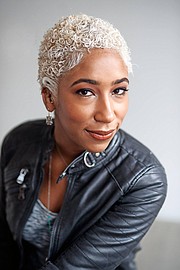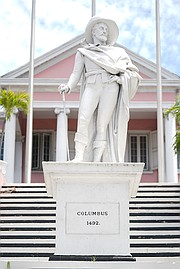Every now and then, the conversation about the statue of Christopher Columbus starts again. It generally does not last for a long time, but people weigh in and we end up with the same sets of opinions. Some people think it should be removed from Government House while others think it should stay.
Of the people who believe it should be removed, some want it destroyed while others say it would be better to put it in a museum and provide context to make it clear he was not a hero, but a genocidal murderer. Most of the people who want it to stay seem to think it is must remain to preserve history. They view it as a harmless relic with little meaning attached and should not evoke any negative feelings.
Still others argue the statue is not the problem and suggest it is useless to get rid of it when Government House remains, the Governor General continues to represent the Queen and she is the head of state.
To be clear, the Columbus statue is not the entire problem. No one ever said it was that simple. We have, however, noted the issue of its prominent location which suggests it represents a person deserving of attention and reverence. We know this is far from the truth. It is not even accompanied by a plaque with the truth about Columbus and what he did after landing on San Salvador in 1492.
We cannot assume that people know the history. It was not long ago that Columbus Day and Discovery Day were celebrated. People in their thirties and twenties were taught a completely fallacious history about the man and would know no better if not for conversations of this kind.
We know the statue of Columbus is the tip of the iceberg. Beneath the surface is colonization, slavery and racism in various forms including systemic and internalised. We have not generally been enthusiastic about these conversations either. The lack of discussion has brought us to this place, barely able to sort through the interconnected issues that demand our attention if we are to move forward and build a more inclusive, equitable nation.
There is no shortage of issues to address that are both related to the statue we can see every day and rooted in systems that are hundreds of years old and that we have learned to ignore in our daily lives. Those issues need our attention, however, they do not detract from the point being made by the people who want the statue removed. It is in an inappropriate location. It sends the wrong message. There are no sound arguments for keeping it there. We will not be banned from discussing other relevant issues if we dare to move it before we eradicate racism.
Do we care more about where we start, or starting at all?
The response to the call for the removal of the statue has not been unlike many other conversations taking place nationally. There is an enthusiastic opposition that does not necessarily disagree with the idea, but is being excessively critical of the call because they would prefer a different starting point or want the conversation to be rooted in a different area. They want to focus on a larger issue. They assume the removal of the statue is a failure to acknowledge the complication of its site.
One of the reasons it is difficult to make progress on issues like this one is the need for people to control narratives and assert themselves as superior in knowledge. It is entirely possible to support the removal of the statue while calling attention to the existence of Government House, the role of the Governor General, continued allegiance to the Queen and the cost of this useless system.
We can make plans to move the statue in two weeks and sustain conversations about why it was put there in the first place and the work that still needs to be done up to and far beyond that date. We are not limited to one statue, one conversation nor one course of action. The conversation will not end when the statue is gone if the people who care about more than the statue are dedicated to continuing it. We have to accept responsibility for our roles in this work and understand everyone is not in the same place or called to the same tasks. It is still possible to work with them and build on their actions.
The removal of statues in the US and Bristol in the UK reignited the conversation about the Christopher Columbus statue. It does not mean we are going to ignore everything and getting rid of the statue will be the end of our work. What is happening around the world is the building of momentum. It is creating a wave of actions that are inspired by those that precede it. Now is a good time to make moves.
If some of us want to talk about systemic racism in this majority black country — much to the chagrin of the people who benefit from it — and other people want to move a statue and we see the connections between the two, let’s talk about it. Note the commonalities. Support the action. Bring context to the conversation. Know that we can do both.
Let new people in and let them learn and grow
Many of the people participating in conversations about current events and underlying systems are new to them. Some are just becoming radicalised as they watch what is happening around us. Sometimes the instinct of more seasoned activists is to silence or push them out, insisting they are not ready, they will get in the way, or they are too late. It is often a protective measure. We do not want to see the work go to waste and we do not want movements to be co-opted.
Locking people out, however, is the result of leading with fear. It may be completely reasonable to have concerns about people’s intentions, especially when they come to a cause like Black liberation at a time like this, but we always need more people. Those of us who have been here before have the responsibility to help newcomers to learn, practice, correct mistakes, be open to new information, share ideas and bring more people. We cannot do it alone.
There has to be space in movements for newcomers and that space has to be actively created. We can easily pinpoint organisations with leaders who have refused, over many years, to train other people for leadership and ensure the continuity of the work.
The newcomers do not need to immediately become leaders, but they need to be welcomed and have a place to learn, work and grow. They need to have access to information, be connected with supporters, get experience with the media, know how to plan events, and understand the history and the trajectory of the movement.
It all starts with letting them in. They may come late, they may come full of emotion, they may come with more passion than know-how and they may come with ideas counter to what has already been decided, but they come. They come with much-needed energy. Let them in, let them see, let them do.
One day, the leaders we know now will be gone and there will still be work to do. There will be progress and there will be successors if we understood movements need more people.






Comments
DDK 5 years, 6 months ago
While we are at it, let's remove San Salvador 🤣 Let's just erase ALL history that bothers us, e.g. the face on the Bahamian one dollar note.
moncurcool 5 years, 6 months ago
We need to deal with the island that is the real San Salvador and not the fake one carrying the name
bogart 5 years, 6 months ago
Andros island named after english Administrator Sir Edmund Andros working in America. Sir Edmund Andros being shareholder of Royal African Company with likes of Edward Colston whi h company business was to get control pf slavery business in Africa. Colston statue recently got removed.
bogart 5 years, 6 months ago
Woodes Rogers the Appointed Royal Governor of the Bahamas who had led the nation into governance deserves his statue to be within the Governor's enclosure on top of Fitzwillian Hill.
Rogers duty brought out the motto on previous Coat of Arms Prirates expelled commerce restored. The nation to this day flourishes under that banner. Rogers had vast experiences in commerce, toil and trouble in business and overcome his challenges. Everyone in nation benefits from commerce.
Rogers spent more of his life than Columbus in working for the creation and stability and growth of the Bahamas nation. Rogers had worked and died in the Bahamas and buried apparently somewhere on old graveyard area by Post Office now sitting on land outside Government House.
themessenger 5 years, 6 months ago
Does this woman honestly believe that moving white man Columbus white statue from where it has stood for the last couple hundred years is going to empower or change in any way the situation of black Bahamians, or eradicate racism by stirring up further needless resentment among the more ignorant of our people? She would be better turning her literary talents into explaining why after half a century of black majority rule we still have to lean on the old crutch of the white boogie man to explain our numerous failings during that period. Is our current system of governance any less useless than our continued allegiance to the Queen and Commonwealth? I suggest we replace Columbus statue with one of the Father of The Nation, a man who ruthlessly crushed anyone, black or white, who stood in his way. A man who lifted us to the pinnacle of Black Majority Rule only to later plunge us into the pit of corruption, drug abuse, crime and poverty that our country has become today. How do you intend to address and change that Ms. Wallace?
tribanon 5 years, 6 months ago
Couldn't agree more with your thoughts here.
Sign in to comment
OpenID